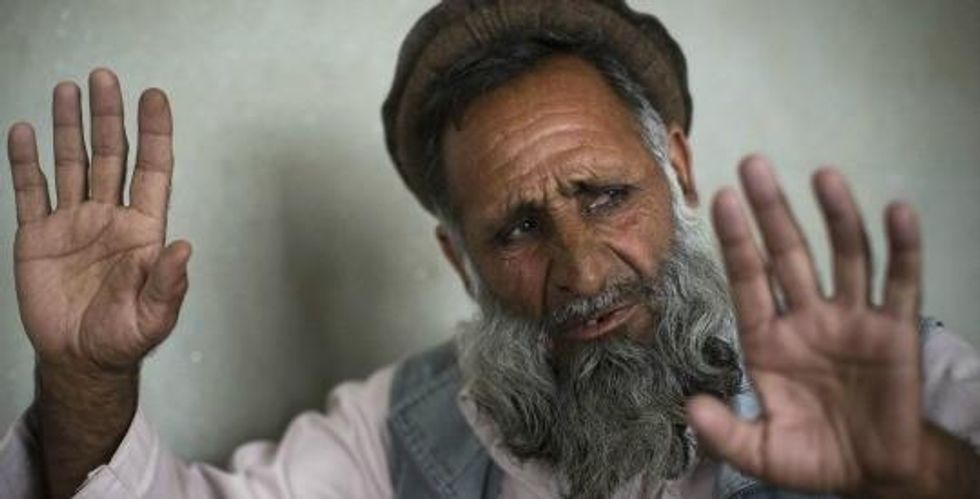Reporting from Afghanistan on Thursday, the
Associated Press has published a first hand account of Afghan civilians living under the constant terror of U.S. drone strikes.
The reporting by the AP--which the news outlet admits followed "a rare on-the-ground look unaccompanied by [US] military or security"--allowed them to explore the toll the US drone war has taken on regular Afghans living under the terrifying reality that missiles from the remotely operated aircraft could strike at any moment.
The report begins:
Barely able to walk even with a cane, Ghulam Rasool says he padlocked his front door, handed over the keys and his three cows to a neighbor and fled his mountain home in the middle of the night to escape relentless airstrikes from U.S. drones targeting militants in this remote corner of Afghanistan.
Rasool and other Afghan villagers have their own name for Predator drones. They call them benghai, which in the Pashto language means the "buzzing of flies." When they explain the noise, they scrunch their faces and try to make a sound that resembles an army of flies.
"They are evil things that fly so high you don't see them but all the time you hear them," said Rasool, whose body is stooped and shrunken with age and his voice barely louder than a whisper. "Night and day we hear this sound and then the bombardment starts."
The Bureau of Investigative Journalism recently reported that 1 in 4 missiles in Afghan airstrikes are now fired by drone, in addition to the other forms of bombardment that have caused unspeakable harm to Afghan civilians.
"Night and day we hear this sound and then the bombardment starts."
The impact of the US drone war on civilians living in the villages below was explored in a report last year by researchers at Stanford and New York University--called Living Under Drones (pdf)--which found that civilians in Pakistan were being "terrorized" by the drones. In addition, the report concluded the program was ultimately "counterproductive" when it came to addressing international law, security, and human rights.
Following the release of that report, Clive Stafford Smith, from the human rights group Reprieve, remarked: "An entire region is being terrorized by the constant threat of death from the skies. Their way of life is collapsing: kids are too terrified to go to school, adults are afraid to attend weddings, funerals, business meetings, or anything that involves gathering in groups."
And Jennifer Gibson, part of the research team for the Living Under Drones project, wrote:
People in the United States imagine that drones fly to a target, launch their deadly missiles with surgical precision and return to a U.S. base hundreds or thousands of miles away. But drones are a constant presence in the skies above the North Waziristan tribal area in Pakistan, with as many as six hovering over villages at any one time. People hear them day and night. They are an inescapable presence, the looming specter of death from above.
And that presence is steadily destroying a community twice the size of Rhode Island. Parents are afraid to send their children to school. Women are afraid to meet in markets. Families are afraid to gather at funerals for people wrongly killed in earlier strikes. Drivers are afraid to deliver food from other parts of the country.
Speaking to the AP, Rasool confirmed these sentiments and condemned the impact of the bombing campaigns, led by the U.S. "These foreigners started the problem," Rasool said of international troops. "They have their own country. They should leave."
Visiting another Afghan village, the AP talked with Said Habib, the principle of a school that was destroyed after US missiles were fired from a suspected US drone.
"Everyone knows the sound of the unpiloted planes. Even our children know," Habib said.
The elders were critical of the U.S. attack. They said they would have preferred that the Afghan soldiers try to negotiate with the Taliban to leave the school and surrender.
Habib and the village elders recalled the attack while sitting in the middle of the devastated school, where debris was still scattered across a vast yard. They pointed toward a blackboard, pockmarked with gaping holes.
"Shamefully they destroyed our school, our books, our library," said Malik Gul Nawaz, an elder with a gray beard and a pot belly.
Habib said that in an attempt to rebuild the school, a contractor constructed a boundary wall before another Taliban attack. He fled with nearly $400,000 in foreign funds.
A video short from the Living Under Drones project:
_______________________



